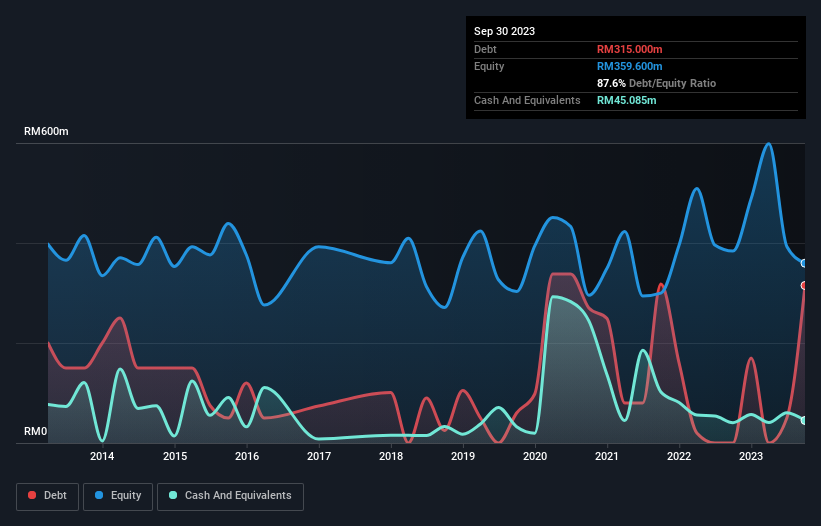These 4 Measures Indicate That Heineken Malaysia Berhad (KLSE:HEIM) Is Using Debt Reasonably Well

David Iben put it well when he said, 'Volatility is not a risk we care about. What we care about is avoiding the permanent loss of capital.' When we think about how risky a company is, we always like to look at its use of debt, since debt overload can lead to ruin. As with many other companies Heineken Malaysia Berhad (KLSE:HEIM) makes use of debt. But the more important question is: how much risk is that debt creating?
When Is Debt A Problem?
Debt is a tool to help businesses grow, but if a business is incapable of paying off its lenders, then it exists at their mercy. In the worst case scenario, a company can go bankrupt if it cannot pay its creditors. However, a more common (but still painful) scenario is that it has to raise new equity capital at a low price, thus permanently diluting shareholders. Having said that, the most common situation is where a company manages its debt reasonably well - and to its own advantage. The first thing to do when considering how much debt a business uses is to look at its cash and debt together.
Check out our latest analysis for Heineken Malaysia Berhad
What Is Heineken Malaysia Berhad's Debt?
As you can see below, at the end of September 2023, Heineken Malaysia Berhad had RM315.0m of debt, up from none a year ago. Click the image for more detail. However, because it has a cash reserve of RM45.1m, its net debt is less, at about RM269.9m.

A Look At Heineken Malaysia Berhad's Liabilities
According to the last reported balance sheet, Heineken Malaysia Berhad had liabilities of RM878.5m due within 12 months, and liabilities of RM37.4m due beyond 12 months. On the other hand, it had cash of RM45.1m and RM524.6m worth of receivables due within a year. So its liabilities outweigh the sum of its cash and (near-term) receivables by RM346.2m.
Of course, Heineken Malaysia Berhad has a market capitalization of RM7.82b, so these liabilities are probably manageable. Having said that, it's clear that we should continue to monitor its balance sheet, lest it change for the worse.
In order to size up a company's debt relative to its earnings, we calculate its net debt divided by its earnings before interest, tax, depreciation, and amortization (EBITDA) and its earnings before interest and tax (EBIT) divided by its interest expense (its interest cover). The advantage of this approach is that we take into account both the absolute quantum of debt (with net debt to EBITDA) and the actual interest expenses associated with that debt (with its interest cover ratio).
Heineken Malaysia Berhad's net debt is only 0.44 times its EBITDA. And its EBIT covers its interest expense a whopping 112 times over. So you could argue it is no more threatened by its debt than an elephant is by a mouse. But the other side of the story is that Heineken Malaysia Berhad saw its EBIT decline by 5.1% over the last year. That sort of decline, if sustained, will obviously make debt harder to handle. There's no doubt that we learn most about debt from the balance sheet. But it is future earnings, more than anything, that will determine Heineken Malaysia Berhad's ability to maintain a healthy balance sheet going forward. So if you want to see what the professionals think, you might find this free report on analyst profit forecasts to be interesting.
Finally, while the tax-man may adore accounting profits, lenders only accept cold hard cash. So the logical step is to look at the proportion of that EBIT that is matched by actual free cash flow. During the last three years, Heineken Malaysia Berhad produced sturdy free cash flow equating to 56% of its EBIT, about what we'd expect. This free cash flow puts the company in a good position to pay down debt, when appropriate.
Our View
The good news is that Heineken Malaysia Berhad's demonstrated ability to cover its interest expense with its EBIT delights us like a fluffy puppy does a toddler. But, on a more sombre note, we are a little concerned by its EBIT growth rate. When we consider the range of factors above, it looks like Heineken Malaysia Berhad is pretty sensible with its use of debt. While that brings some risk, it can also enhance returns for shareholders. There's no doubt that we learn most about debt from the balance sheet. However, not all investment risk resides within the balance sheet - far from it. To that end, you should learn about the 3 warning signs we've spotted with Heineken Malaysia Berhad (including 2 which are a bit concerning) .
If, after all that, you're more interested in a fast growing company with a rock-solid balance sheet, then check out our list of net cash growth stocks without delay.
Valuation is complex, but we're here to simplify it.
Discover if Heineken Malaysia Berhad might be undervalued or overvalued with our detailed analysis, featuring fair value estimates, potential risks, dividends, insider trades, and its financial condition.
Access Free AnalysisHave feedback on this article? Concerned about the content? Get in touch with us directly. Alternatively, email editorial-team (at) simplywallst.com.
This article by Simply Wall St is general in nature. We provide commentary based on historical data and analyst forecasts only using an unbiased methodology and our articles are not intended to be financial advice. It does not constitute a recommendation to buy or sell any stock, and does not take account of your objectives, or your financial situation. We aim to bring you long-term focused analysis driven by fundamental data. Note that our analysis may not factor in the latest price-sensitive company announcements or qualitative material. Simply Wall St has no position in any stocks mentioned.
About KLSE:HEIM
Heineken Malaysia Berhad
Produces, packages, markets, and distributes alcoholic beverages primarily in Malaysia.
Proven track record with adequate balance sheet and pays a dividend.
Market Insights
Community Narratives




